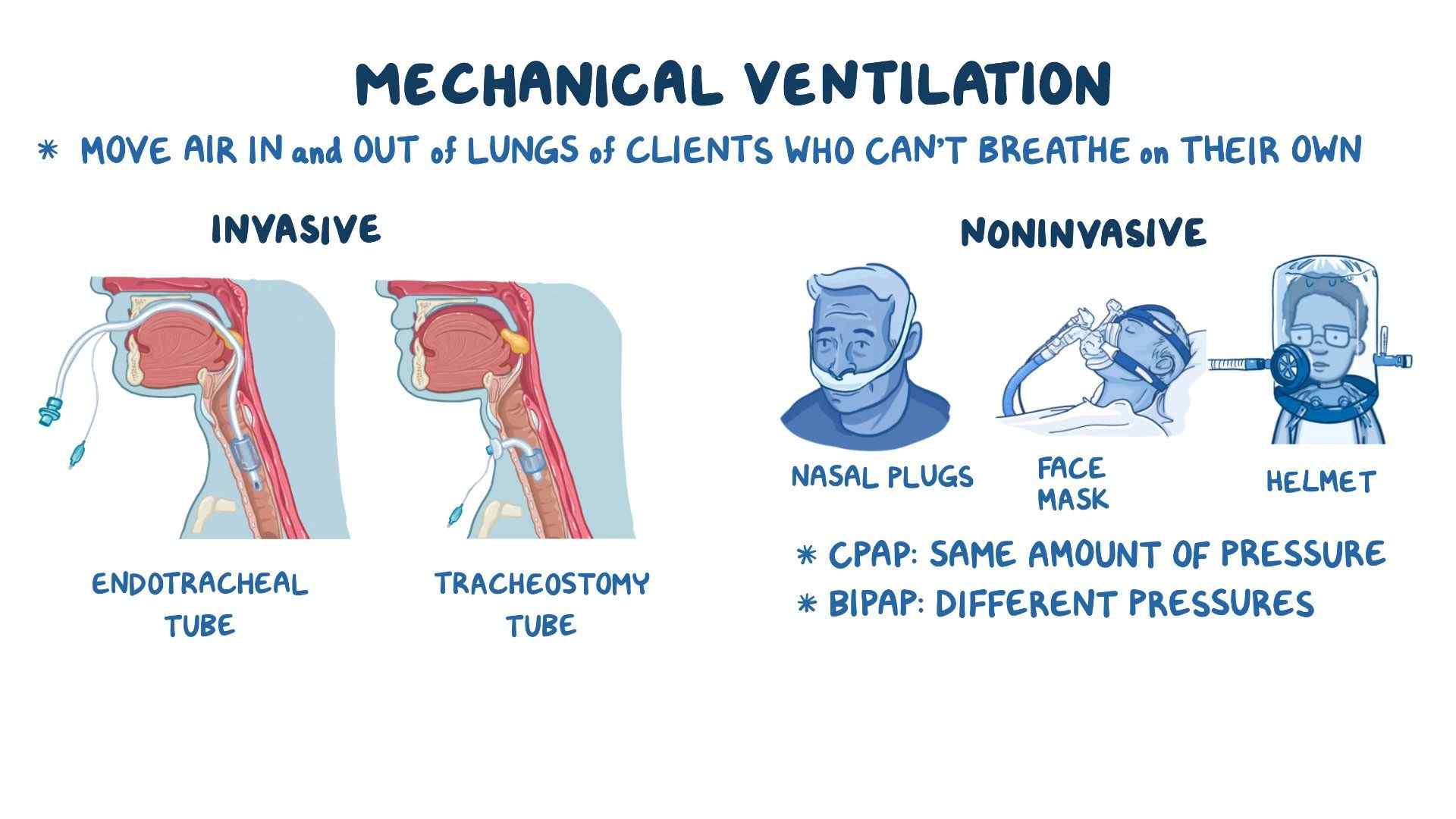Mechanical ventilation NCLEX questions
Mechanical ventilation equipment is used to provide oxygen to patients having difficulties breathing on their own. Mechanical ventilators are portable, or floor-based and offer continuous or intermittent positive-pressure ventilation. Effective usage of ventilators broadly explored in the mechanical ventilation NCLEX questions is a crucial skill that every nurse should have.
As a professional nurse, it is crucial to understand and select effective mechanical ventilators for patients. Responsibilities for nurses include evaluating and watching patients' progress while on ventilators. Before taking the licensure exam, mechanical ventilation NCLEX questions can help you master the ventilator questions. Naxlex contains curated ventilator questions guaranteeing an A on the exam; try them now .
Important concepts in mechanical ventilation NCLEX questions
Mechanical ventilation NCLEX questions examine crucial content areas that nurses must understand to offer effective mechanical ventilation support services. Understanding mechanical ventilation system operations is necessary to offer holistic nursing support. The following topics and concepts are explored broadly to equip nurses with the skills they need for ventilator treatment procedures.
-
Mechanical ventilation basics
-
Ventilator settings
-
Types of mechanical ventilators
-
Nursing problem priorities
-
Treatment and nursing interventions
-
Handling patient complications
Mechanical ventilation basics
Mechanical ventilation is a sophisticated treatment option that requires specialized nursing skills in ventilator mechanics, critical thinking, and timely decision-making during nursing emergencies. The equipment is connected to oxygen to aid the patient's breathing. Mechanical ventilation NCLEX questions will help you master fundamental mechanical ventilation systems.

Ventilator settings
Proper ventilator settings are a priority to ensure patients receive proper breathing support. Understanding ventilator settings is mandatory to choose the correct settings for mechanical ventilation. Proper settings promote the client’s safety, and comfort while using this life-saving equipment. Mechanical ventilation NCLEX questions can familiarize you with the ventilator settings you need to understand before the exam.
Types of mechanical ventilators
Mechanical ventilators are classified according to the methods in which they support ventilation. Two popular categories are; negative-pressure and positive-pressure ventilators. Positive-pressure ventilators inflate the lungs by producing positive pressure on the airway. This pressure exertion pushes air in and forces the alveoli to expand during inspiration.
Negative-pressure ventilators are placed in the thorax and abdomen to promote lung inflation by distending the rib cage and abdomen. Negative-pressure ventilators are not used as often as positive-pressure ventilators. However, many healthcare facilities have utilized negative-pressure mechanical ventilation methods for clients with acute respiratory failure until the Copenhagen polio epidemic in the early 1950s.
Nursing problem priorities
When dealing with patients put on mechanical ventilators, there are deliverable objectives that nurses aim to achieve. The nursing priorities for clients receiving mechanical ventilation support include;
-
Ensuring a stable airway and good placement of the endotracheal tube
-
Close monitoring and management of the client’s respiratory status
-
Close monitoring and management of patient’s sedation levels and pain control
-
Complications assessment and managing any potential emergencies
-
Preventing complications linked with mechanical ventilators such as; pneumonia, and lung injury
-
Collaborating with other healthcare team to optimize mechanical ventilation settings
Treatment and nursing interventions
Nursing interventions and care for patients put on mechanical ventilators require both technical expertise and sound communication skills. Intervention procedures may vary depending on the patient's condition, however pulmonary auscultation and interpretation of arterial blood gas are critical. Nurses play an important role in detecting changes in assessment findings and identifying complications before they occur.
Holistic nursing assessment and strong nurse-client relationships are important to provide optimal care for patients under mechanical ventilation systems. Dependency on mechanical ventilators can bring fear to the patient and the family. Patients may become withdrawn or depressed. Effective communication from nurses and other healthcare teams can help reduce anxiety and fear associated with mechanical ventilators.
Patients under mechanical ventilators may require drug administration and pharmacological support. Drugs used during mechanical ventilation therapies aim to maintain proper respiratory functioning and patient comfort. Medications may include sedatives and analgesics to promote patient comfort. Medications used include; induction agents, paralyzing agents, opioids, diuretics, vasopressors and inotropes, and more.
Handling patient complications
Complications can happen to patients under mechanical ventilation at any stage. Sometimes, the complications can be serious and life-threatening. Different assessments can be conducted to identify possible complications. The following are common assessments and nursing interventions performed to prevent respiratory injuries to patients during mechanical ventilation.
-
Reviewing the mechanical ventilation settings every hour especially the tidal volume and plateau pressures. If there is any discrepancy in the ventilator settings, the nurse should notify the respiratory unit immediately. Frequent ventilator assessment ensures the client is receiving optimal care.
-
Evaluating the respiratory levels and rhythm including the work of breathing. It is crucial to maintain the patient in harmony with the ventilator and ensure no “bucking” is permitted. Any adjustment needed should be done swiftly.
-
Evaluating arterial blood gas results and monitoring oxygen saturation. The data obtained is used to guide the ventilator settings and performance of appropriate interventions.
-
Monitoring plateau pressures with the respiratory therapist. The pressure of the ventilator should be maintained to prevent exhalation.
-
Ensuring the mechanical ventilator alarm is always on. The ventilator alarm is crucial as it notifies the caregiver in case there are ventilation issues. A swift response to the alarms ensures the problem is solved to enhance optimal breathing processes.
-
Listening to alarms to understand the range in which the ventilator sets off the alarm and how to troubleshoot the issue. The ventilator is a crucial life-sustaining tool that requires immediate response to alarms. It’s important therefore to understand the ventilator range.
-
Provide nutritional support as required. The respiratory muscles will become weak after a few days. Adequate protein is required to increase the respiratory rate.
The final word on mechanical ventilation NCLEX questions
Mechanical ventilation is an important treatment option for patients with breathing difficulties. Nurses must understand the mechanics of ventilators to provide effective nursing care. Mechanical ventilation NCLEX questions are powerful resources for nurses preparing for NCLEX. A great tool that can help you prepare for the exam effectively is Naxlex. The test prep of choice provides mechanical ventilation NCLEX questions with answers to get you the grade you deserve. If you want to get a guaranteed A in the exam, join Naxlex premium packages and see the difference.
Start your journey with us today
Join 1000+ Nursing Students
Powerful learning and clinical tools combined into one platform. The Naxlex Knowledge and Qbanks give you instant and on-the-go nursing knowledge and guidance.




